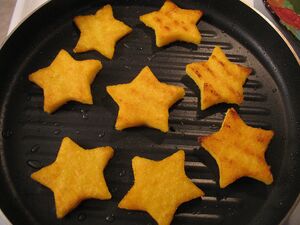

Polenta is made with ground yellow or white cornmeal, (ground maize). It can be ground coarsely or finely depending on the region and the texture desired. As it is known today, polenta derives from earlier forms of grain mush (known as puls or pulmentum in Latin or more commonly as gruel or porridge) commonly eaten in Roman times and after.
Polenta is very similar to corn grits, a common dish in the cuisine of the Southern United States, with the difference that grits are usually made from coarsely ground kernels. When properly cooked, grits and polenta have similarly smooth textures, "grit" referring to the texture of the dried corn before cooking. Another variation uses ground hominy (similar to masa harina), lye-treated corn kernels.
Polenta is similar to boiled maize dishes of Mexico, where both maize and hominy originate.
Similarity with other foods
- In Albania it is called harapash
- In Bosnia, it is called pura
- In Turkey, it is called as muhlama. It is common especially in the northern region of Turkey
- In Croatia, polenta is common on the Adriatic coast, where it is known as palenta or pura; in northwestern part of Croatia and around Zagreb, it is known as žganci. In the Adriatic Croatian coast, polenta goes together with fish or frog stew (brujet, brudet)
- In Slovenia it is also known as polenta, it used to be eaten mainly in the Slovenian Littoral, while in central and eastern Slovenia, it was replaced by the buckwheat, žganci, then almost unknown in the western part of the country
- In Hungary it is known as puliszka and is usually made of coarse cornmeal. Traditionally it is prepared with either sweetened milk or goats' milk cottage cheese, bacon or sometimes mushrooms
- In Portugal it is known as Pirão and on Madeira it is known as Milho Frito
- The Corsican variety is called pulenta, and it is made with sweet chestnut flour rather than cornmeal
- In Bulgaria and the Republic of Macedonia the dish is called kachamak (качамак)
- The Serbian variety is called palenta or kačamak (качамак)
- The Romanian variety is called mămăligă; this word is also common in Russian (Мамалыга), but also known as кукурузная каша). This Romanian variety cooks feta cheese in the polenta
- In southern Austria, polenta is also eaten for breakfast (sweet polenta); the polenta pieces are either dipped in café au lait or served in a bowl with the café au lait poured on top of it.
North and South American
Polenta is very similar to coosh, a dish of boiled cornmeal mush which is also often sliced and fried but which is often eaten with sweet toppings like maple syrup. A common dish in the cuisine of the Southern United States is grits, with the difference that grits are usually made from quickly-cooked coarsely ground kernels or from lye-treated (nixtamalized) kernels (ground hominy).
Polenta is similar to boiled maize dishes of Mexico, where both maize and hominy originate.
The Brazilian variety is also known as angu. Originally made by native Indians, it is a kind of polenta without salt nor any kind of oil. However, nowadays "Italian" polenta is much more common at Brazilian tables, especially in the southern and southeastern regions (which have high numbers of Italian immigrants), although some people still call it "angu". The city of São Bernardo do Campo is notable for its restaurants specialized in frango com polenta (fried chicken with fried polenta).
Polenta is also a very traditional meal in Uruguay
African and Afro-Caribbean
In South Africa, cornmeal mush is a staple food called mealie pap; elsewhere in Southern Africa it is called sadza or phutu-(pap). It is similar to polenta but most often it is not as dense as polenta. In Zimbabwe, phaletshe, in Botswana, and nshima, in Zambia, and "Oshifima" or Pap in Namibia. In East Africa a similar dish is called ugali, named from the Swahili language. Fufu, a starch-based food from West and Central Africa, may also be made from maize meal. In the north of Angola it is known as funge, probable source of names for the dish in a number of Caribbean countries, destination of slaves from Angola and elsewhere along the West Coast. In the Caribbean, similar dishes are Pastelle (Trinidad & Tobago), cou-cou (Trinidad & Tobago and Barbados), funchi (Curaçao), funjie (Antigua and Barbuda) and fungi (Virgin Islands). It is known as funche in Puerto Rican cuisine and mayi moulin in Haitian cuisine.
See also
- Barbecued polenta and sweetcorn patties
- Polenta and sweetcorn patties
- Basic polenta recipe
- Cheese polenta recipe
Find recipes that contain 'Polenta'
#polenta #maize #cornmeal #hominy #grits #romanian #cottagecheese #hungary #nutsgrainsandseeds #portugal #turkey